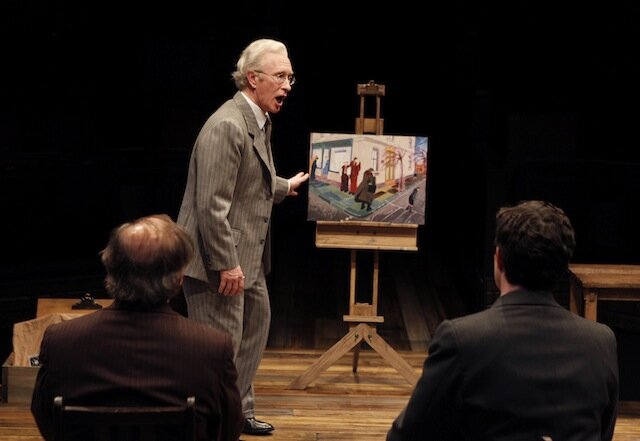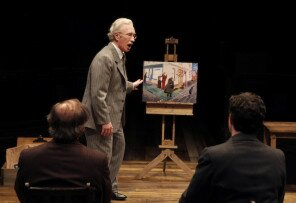
Nearly a year ago, I encountered an asshole with a puppy in his Safeway cart. Since writing about that experience last February, the story continues to inspire opinionated comments, in spurts here and there (TWSS). The most recent comment, from just a couple days ago, certainly had enough time and forethought invested as to warrant a larger audience and hopefully move this conversation forward. The supportive screed, care of SunBreak commentator Sirophix:
Thanks for the article, Audrey. I think it brings up some really important points for Seattle residents. Personally, I agree that non-service dogs should not be permitted in grocery stores or other food and beverage establishments. I have been an animal-lover my entire life and am hoping to get my first very own puppy this summer. I look forward to taking him out and about–but not inside places that prepare and serve food.
Owners of service dogs have given us stories of their dogs being attacked by non-SDs in public areas, and I think this is horrible. Anyone who has ever encountered a truly trained SD knows it’s not your average pet. I’m sure most people won’t appreciate this comparison, but I would describe service dogs as regular dogs whose sparks have been snuffed out. I say this having only seen SDs for a few moments at a time in very busy, very public situations where absolute adherence to training is essential, so it makes sense that there is no room for any of that spontaneous behavior. After all, someone’s life could be at stake.
Perhaps some people would be willing to compile more comprehensive arguments for their points? Personally my argument is dogs (and I say dogs because I think mini-horses are quite rare as service animals) shouldn’t be in restaurants and grocery stores for two main reasons.
(Whether or not children should be allowed in grocery stores is orthogonal and I don’t think it does anything but cloud the issue. For this reason I am not addressing that argument and its points.)
1) Dogs tend to shed fur and dander and can carry and spread many diseases, some of which can be transmitted to humans. I don’t want these things on my food, clothes, or person when I am purchasing food, drink, or groceries.
I don’t think it’s hypocritical to be accepting of one’s own pets in one’s own home. That said, I ensure the food I prepare in my kitchen does not contain pet hair. I don’t have a la-dee-da attitude with that. Maybe it’s a preference, maybe it’s a mindset–I just don’t want to ingest parts of my pets. And I know where my pets go, what they eat, how often they are cleaned, which vaccinations they have, and what their medical histories are! I don’t know these things about strangers’ pets and I’m enough of a misanthrope that I don’t trust other people to be conscientious owners so I assume the worst.
Here is a list of illnesses people can get from dogs from the CDC’s website.
If my pets were to get a communicable illness for whatever reason, I would not want them to pass it to others. If grocery stores were to allow dogs, it’s very possible they would transform into a short step above common dog parks and the chance for diseases would increase dramatically. In the past few years we’ve had quite a few parvo outbreaks in Western Washington. Here’s just one story from Google.
2) Dogs can behave in unpredictable way, which can result in bites to other animals or people. A dog may also urinate, defecate, vomit, bark, run, or growl, among other undesirable behaviors.
Be honest: pretty much everyone knows another person (or is that person) who has a sketchy dog and this dog will bite. It may be due to anxiety or fear or aggression but it really doesn’t matter–a dog bite often is a very traumatic experience–and very preventable–experience.
The person whose dog bites knows that their dog bites. They try to keep an eye on it. But they can’t watch their dog 100% of the time, especially when their primary focus isn’t their dog but their groceries. So the dog bites someone. And there are actual dog-bite attorneys who are more than happy to help the person sue your buns off.
These behaviors are, of course, extremes. Most behaviors that are encountered every day are not this extreme but are incredibly annoying. A dog that does not respect the boundaries of others is probably #1 on that list. While there are some people who don’t mind a strange dog walking directly to them and smelling their ass, there are some people who do.
Assuming you have a well-groomed, vaccinated, well-behaved dog…
Well, it sucks to be you because there are a lot of people whose dogs are not all of those things. So any time one of these ill-trained beasts misbehaves in public, it gives a bad name to all good dogs and responsible owners. Feel free to address the problem yourself and attempt to restore some dignity to the perception of Seattle dog owners. I personally would be happy to switch things up on a trial basis if all the dogs were properly behaved and maintained.
Of course, trained service dogs don’t have the behavioral problems but may have health issues. Until service dog status–or the health of all dogs–is more tightly regulated, the ADA will continue to provide service dogs with carte blanche on this.
Unfortunately, service dog status is not federally regulated status. I say “unfortunately” because if there were a certification that owners could obtain, then they could very easily count themselves as proud owners of truly licensed, regulated, and trained service animals. Just as a restaurant must pass a variety of health codes, I think it would be incredibly beneficial to regulate service animals: for the dogs, the owners, and the public–both the ignorant and the informed. Fringe benefits could be that all owners also receive a medical ID card or bracelet indicating the services their animal performs in case of accident or emergency, and that this certification could assist in insuring service dogs for the full value in case of accident, illness, injury, or death. (These are, of course, hypothetical.)
It is very possible that if such legislation were to one day be enacted, these canines would be considered the models of behavior for all other dogs. Maybe that would have a ripple effect, where their conduct comes to be accepted as the standard and the minimum level of training expected of all pets is significantly improved.
On a separate issue, I have read conflicting information on how to approach a customer with a dog and whether it is a service animal. The WA State Human Rights Commission site states that the customer may be asked if the animal is required because of a disability. When I worked in a doctor’s office, we were instructed not to ask any questions if a patient were to bring a dog, as even asking questions could open us up in terms of liability.
I hope people continue to examine this issue and their beliefs surrounding it. Open, constructive conversations should always be welcome.





